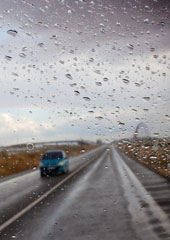Road Tripping Down the Keystone Pipeline
How do we reconcile the growth of oil sands with the fact that we’re entering a carbon-constrained future?
April 20, 2013

In spring 2012, I proposed an unusual road trip, one that would trace the full 1,700-mile route of the proposed Keystone XL oil pipeline. The pipeline project, which I was covering for the Washington Post, had aroused intense controversy.
TransCanada, a Calgary-based company, had applied for an international permit from the U.S. State Department, something that had never raised many hackles before. But activists had turned the pipeline into an environmental litmus test for President Obama.
In late August and early September 2011, pipeline foes protested outside the White House. More than 1,250 people were arrested. The police carted off the likes of Middlebury professor Bill McKibben, actress Daryl Hannah and renowned climate scientist James Hansen. Later that fall, thousands of protesters surrounded the White House.
What made this pipeline different from the more than two million miles of existing oil and natural gas pipelines that had been built in the United States with little fuss or fanfare? A journey by car would provide a window onto what this policy debate looked like at the ground level.
In a rented car — a Ford Flex that made up in roominess what it lacked in grace or style — I set out, accompanied by Post colleagues photographer Michael Williamson and videographer Whitney Shefte and my 18-year-old daughter Natalie, who jumped at the chance to see those vast stretches of America.
We drove through Alberta and part of Saskatchewan, then down the spine of America to the Texas Gulf Coast. We visited spacious corporate headquarters and crammed trailer parks, ranches and farms, boomtowns and dead towns, a border town of nine people and a century-old oil refinery. We attended a Nebraska cookout and an Oklahoma pow-wow. And along the way, this inanimate pipeline came to life.
It became clear that the real story of this pipeline permit was one about American frontiers — the lengths to which we go for oil supplies and the intrusive effects that quest causes all the way down the line.
The tar sands
Our first stop: The gaping black pits at the oil sands, or tar sands, of Alberta, the source of the oil that would flow down the Keystone XL. Those vast tar sands are prologue to the pipeline.
Although the Keystone XL would start in the town of Hardisty — four or five hours drive south of the frontier Alberta boomtown of Fort McMurray — the pipeline would connect with other lines and nearly 90% of the oil it would carry would come from the tar sands. The stuff lurking there and the process used to extract it lie at the heart of the debate over the pipeline.
We got our first look at the oil sands courtesy of Shell, one of several companies working there. We drove from our hotel in Fort McMurray up Highway 63 — often called the world’s biggest cul-de-sac because it comes to a dead end at the northernmost oil sands projects. The highway is lined with boreal forest, mostly wetlands, thick with jack pines, spruce, aspen and tamarack trees. Twice we crossed the Athabasca River, which winds north.
Then the forest parted to reveal clearings where Shell, which is expanding its operations, has started storing top layers of soil in large mounds for reclamation. There was an airport big enough for jets to land with supplies and dorms for 2,500 workers. And there were massive processing plants, tangles of pipes and tanks — or pots and pans, as one worker put it.
Beyond that lay Shell’s Jackpine and Muskeg mines. Unlike oil that spurts up from reservoirs in most of the world, half of Canada’s oil sands are dredged up in a process more akin to strip mining. Trees are cut, lying like casualties. Layers of wetland fen and peat are drained and peeled back, and then the companies dig into a rich layer of oil sands that go down nearly 400 feet.
In areas to the south where the gunky oil lies even deeper, companies are drilling wells, generating and injecting steam into sands below the surface. That melts the bitumen so that it has the consistency of molasses and can be sucked up to the surface.
To appreciate the scale of the oil sands projects, we started inside Shell’s supersized repair shop. There Shawn Flett stood 30 feet above the ground on the deck of a truck the size of a house. He had just waved it gingerly in as if guiding an airplane into a hangar.
We gawked at this beast of a machine, sporting 14-foot tires and weighing in at more than a million pounds. The truck burns 50 gallons of diesel an hour and, Flett joked, “it handles like a Cadillac.”
Outside the shop, fleets of these Brobdingnagian trucks, each one carrying 400-ton loads of black sands, rumbled across the giant open-pit mines. The trucks lugged the black sands to conveyer belts that feed into a series of processing facilities, which mix the sands with warm water, skim off the oil and spit what’s left over — known as tailings — into dark “ponds.”
The oil sands — a black, gooey and lucrative mixture of sand, oil and water — are easy for the companies to find. The viscous petroleum, or bitumen, is so common that, in some places, it oozes out along the banks of the Athabasca River and was used by Native Americans to seal canoes. Today there’s more at stake than plugging boat holes.
Canada’s economically recoverable oil sands are an immense prize estimated to hold about 170 billion barrels of crude oil, reserves second in size only to Saudi Arabia. The Canadian Association of Petroleum Producers estimates that production, now 1.7 million barrels a day, could nearly double by 2020, enough to supply nearly 20% of U.S. oil consumption. With that, the region would produce more than Venezuela, Nigeria or Kuwait.
The rush to expand has been fueled by high oil prices, which for the past six years have held above the $50 per barrel threshold needed to make the oil sands projects profitable.
A Rorschach test on energy
All that new oil production needs someplace to go, and TransCanada’s proposed Keystone XL pipeline would link Alberta to the oil refineries on the Texas coast of the Gulf of Mexico. But the pipeline has become a powerful symbol and political pawn.
It is also a sort of Rorschach test of how Americans view energy issues: Are we energy rich or energy poor? How do energy policies affect job creation, tax revenue and U.S. manufacturing competitiveness? How pressing are climate-change concerns, and how do we balance them with economic priorities?
The American public is firmly behind the pipeline. A Washington Post poll in 2012 found nearly six in 10 saying the U.S. government should approve the project. About 83% think it will create jobs. Nearly half think it will not cause significant damage to the environment.
The oil industry and many national security experts think that importing more oil from Canada, a stable neighbor and ally, will make the United States more secure. They worry that, without the Keystone XL, Canada will send that oil to China.
But the process of extracting oil from the sands has alarmed people worried about climate change. Climatologist James Hansen has said that if the Canadian oil sands are fully developed, it would be “game over” for the planet’s climate.
Mining or melting tar sands to extract bitumen is extremely energy intensive, Hansen says. Even after heating the sands, companies must upgrade or mix the bitumen with lighter oil — a combination known as dilbit — so that it can flow through a pipeline. Overall, producers expend energy equal to one barrel of oil to extract four to eight barrels from the oil sands.
More energy expended means more greenhouse gases. A Congressional Research Service report released in 2012 estimated that Canada’s oil sands produced 14-20% more greenhouse gas emissions than the average barrel of U.S. imported crude oil — or comparable to low-quality Venezuelan crudes.
By other standards, however, oil sands look worse. The “well to tank” emissions (those created just to get the gas to the car) of Canadian oil sands are about twice as high as the average U.S. crude import. In addition, stripping the wetlands of peat and fen — which naturally store carbon dioxide — compounds the problem, says Jennifer Grant, oil sands director at the Pembina Institute, a Calgary-based think tank.
That’s why foes of the Keystone XL have turned the pipeline, just one of many built or expanded every year, into a test of President Obama’s commitment to slowing climate change.
“The projects themselves are enormous and ugly — but even uglier is the freight of carbon they contain,” says Bill McKibben, the Middlebury College professor who has been a leading voice against the pipeline. “That’s the second-largest pool of carbon on Earth…. No one who is serious about fighting climate change can want to see that oil out of the ground and into the air.”
A Necessary evil?
The oil sands will be needed even if people use oil more efficiently, says John Abbott, executive vice president for heavy oil at Shell Canada. World population growth and rising living standards in developing countries will soon double global oil demand, he adds.
“All forms of energy have an impact, and it’s Shell’s role to ensure that whatever form of energy it generates is done in the most environmentally acceptable manner that the industry knows how to do,” Abbott says. “Once we get to that point, you cannot expect any more from an industry.”
A few weeks after our visit, Shell decided to go ahead with a project that will capture carbon dioxide emissions from a plant near Edmonton that upgrades the tar sands oil. Shell would then store the carbon dioxide in geological formations to keep it out of the atmosphere. The provincial government of Alberta and the federal government of Canada have agreed to put in $865 million, more than half the cost over the first decade.
By burying about a million tons of carbon dioxide a year, Shell would bring the greenhouse gas profile of its oil sands close to parity with other U.S. imports, Shell said. Overall, however, the oil sands industry emits more than 30 million tons of carbon dioxide a year — equivalent to the emissions of 4.7 million passenger cars — and will emit more as it expands.
“The big question is how do we reconcile oil sands growth with the fact that we’re entering a carbon-constrained future,” Grant says.
The oil sands emissions are making it difficult for Canada to meet the greenhouse gas targets it agreed to in the 2009 international Copenhagen Accord. But Travis Davies of the Canadian Association of Petroleum Producers says they make up 0.1% of global emissions and shouldn’t be singled out. That figure covers the emissions just for getting the oil out of the ground and into the pipeline in Alberta.
Disproportionate focus?
Many Canadians are angry that environmentalists have targeted the oil sands industry.
At The Tavern in Fort McMurray, where we later grabbed a bite to eat, a poster just inside the door said: “Conflict Oil” with a photo of Venezuelan President Hugo Chavez. Beneath him, it said “forced labor.”
Under “Ethical oil” was a smiling, clean-cut guy in a hard hat. Below him, it read: “Good jobs.” A best-selling book called “Ethical Oil” argues that tapping the oil sands is ethically preferable to helping the economies of Saudi Arabia or Venezuela, countries that lack many human rights.
TransCanada’s CEO Russ Girling said that U.S. environmental groups “seemed to coalesce around our project with the narrative that if you shut down the pipeline, you shut down the fuse to the largest carbon bomb on Earth. That just isn’t correct.”
“Do we have challenges? Yes,” said Brad Bellows, a spokesman for MEG Energy, which showed us their steam-injection operations south of Fort Mac. But he said much of the criticism of oil sands development was “political, misleading or downright wrong.”
To many Canadians, the oil sands development takes a modest bite of land in a province two-thirds bigger than California. From a helicopter, the mammoth trucks look like toys and the forest stretches north as far as the eye can see.
Large-scale extraction and impact
To some, the oil sands development raises environmental issues that include the effects on caribou, the loss of wetlands and the giant tailings ponds used to store mining waste. The ponds contain water, fine silts, bitumen, toxic napthic acid and solvents. Ditches outside the berms collect water and pump it back into the ponds. Shell recycles up to 85% of the water it uses, but it’s still using 2 to 2.5 barrels of water for every barrel of oil.
Though the amount of leftover oil in the ponds is small, it floats to the surface, posing a menace to any bird foolish enough to splash down. Shell uses radar to detect incoming birds. It triggers a signal to floating platforms with fake predator birds to sound fake predator calls, as well as fire cannons to frighten the real birds away.
The process of extracting the bitumen isn’t technically complicated and hasn’t changed since it was patented in the 1920s by a University of Alberta scientist, Karl Clark.
Essentially, the oil sands are mixed with warm water. The sand sinks to the bottom, the water and suspended clay sit in the middle and the oil floats on top. Shell explained the process by showing us a couple of glass jars with layers of separated mixture.
It’s the scale of the operation that’s daunting. Syncrude, a joint venture of half a dozen companies that includes China’s Sinopec and Arkansas-based Murphy Oil, is one of the biggest oil sands producers.
We had a good look from a helicopter we rented on our third day in Fort McMurray. Its plant, which partially refines the viscous oil, juts up along the Athabasca River. Piles of sulfur the size of giant warehouses sit in the open. Clouds of dust kicked up by the big trucks floated over the land.
The payoff: For every 400-ton truckload of oil sands, the companies get 200 barrels of oil. With crude oil selling for $80 to $100 a barrel, that’s very profitable.
Shell does internal evaluations of project economic viability using a hypothetical carbon emissions price of $40 a ton for carbon dioxide, even though at the moment there is no carbon tax or cap-and-trade program imposing such a fee. But the $40 price is far above prices on Europe’s carbon exchange, and the oil sands still pass financial muster, Abbott said.
Can the companies clean up when they’re finished here?
The reclaimed areas won’t be as flat for one thing. The ground, now less compact, will be higher, which means fewer wetlands. Moreover, the Pembina Institute says only 1% of the tailings ponds have been replanted. Even if land can be reclaimed, a costly undertaking, the greenhouse gases will be long gone into the atmosphere.
Cheryl Robb, a Syncrude media relations person, stopped her pickup at an area the company has reclaimed.
A field of young trees — jack pines, aspen, spruce — was springing up above an idyllic pond. Small cannons sounded just over the hill to scare off birds that would die if they landed on the oily surface of tailings ponds. Trucks and buses barreling down Highway 63 were audible. Beyond the hill, the stacks and pipes of a processing facility loomed in the distance.
Editor’s note: This article is adapted from Keystone XL: Down the Line: A Journey Along the Controversial Pipeline and Into America’s Energy Frontier (TED Conference) by Steven Mufson. Published by arrangement with the author. Copyright © 2013 by Steven Mufson.
Takeaways
Canada's economically recoverable oil sands are estimated to hold about 170 billion barrels of crude oil, reserves second in size only to Saudi Arabia.
Production from Canada's oil sands, now 1.7 million barrels a day, could nearly double by 2020, enough to supply nearly 20% of U.S. oil consumption.
One report estimated that Canada's oil sands produced 14-20% more greenhouse gas emissions than the average barrel of U.S. imported crude oil.
The oil sands industry emits more than 30 million tons of carbon dioxide a year -- equivalent to emissions of 4.7 million passenger cars -- and will emit more as it expands.
Shell recycles 80-85% of the water it uses, but it's still using 2 to 2.5 barrels of water for every barrel of oil.

